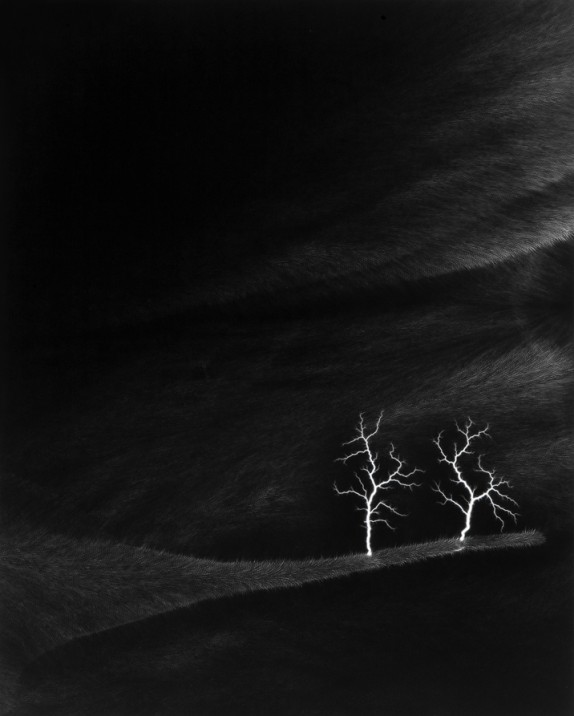
First Thursday, San Francisco's defacto night for art openings, slightly delayed by Labor Day and Burning Man, turned into a fantastic Second Thursday with several great photography shows at 49 Geary and Gallery 291 last night. For sure the star of the evening was Hiroshi Sugimoto, the mad scientist of the fine art photo world, his newest body of work called Lightning Fields is a set of stunning black and white images Sugimoto creates by applying 400,000 volts of electricity directly to the film with a Van De Graffe generator. I found a couple of great videos of Sugimoto talking about his work. They are
here and
here. Listening to him one understands he is an intellectual, educated in architecture, history and science, and his work draws on broad and deep concepts about the natural and man-made environment.
With gallery and museum shows around his work and the cover art of the current U2 album "No Line on the Horizon" Sugiomoto's work demands a high price. The print of the above picture is $80,000 at Frankel. If I were in the market for a Mercedes I think Sugiomoto's print would be a better use of the money. Until the lottery winnings come in I have this Fujiroid from his show with an extra bit of lightening from on-camera flash. Richard Prince can only hope to re-photograph an image this well.
Next we went upstairs to Haines Gallery. I was blown away for the second time of the night, this time by Adou Samalada's work. His images of his native Sichuan Province in China are beautiful and timeless. Adou works with old expired film to create portraits which are poetic and heroic. They seem to come from some remote past but they are current documents of his life.
"There is no difference between taking a picture of others and myself. The camera may be pointed outward, but whether you like it or not, it always reveals you."

At Haines I met Zara from
Fifty Crowes I'm hoping she will sit for me so I can make a portrait of her with all those amazing freckles. Zara is busy working on an opening 50 Crows is doing with Ed Kashi on October 1. More on Ed on Fifty Crows blog
here.
After Adou we went to
Brian Ullrich's show at Robert Koch. Brian is the receipient of a Gugenheim for his work on the malls and other remnants and detritus of our shopping culture. He writes:
Over the past 7 years I have been engaged with a long-term photographic examination of the peculiarities and complexities of the consumer-dominated culture in which we live. This project titled Copia, explores not only the everyday activities of shopping, but the economic, cultural, social, and political implications of commercialism and the roles we play in self-destruction, over-consumption, and as targets of marketing and advertising.
Living in San Francisco where we feel the effects of the economy but don't see the wreckage in the obvious way that it has been wrought in other parts of the country. It's kind of jarring to realize that Brian's images document our home not some far off place.


Fujiroid of Miki Johnson from
Reslove talking to Brian at his opening.
The last stop of the evening was for one of my personal favorites, Michael Garlington at Gallery 291. His images are beautiful, dark narratives, photographs from Grimm's Tales, beadtime stories to terrify children. Garlington was a master printer as well as a photographer. His personal work is masterful in its own right but with a low-fi, noisy, dirtiness that would be the opposite of the work he did as a printer. His images like Adou's are current but appear to be plucked out of the past.

Here is a Fujiroid of someone iPhoning a Garlington image.
Here is the info for Michael's show at 291. You can also buy his book
Portraits from the Belly of the Whale on
Amazon or at 291.





















